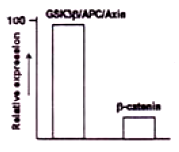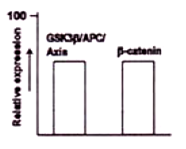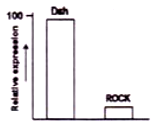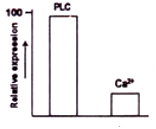 Multiple Choice Questions
Multiple Choice QuestionsWhich one of the following graphs represents the relative expression of proteins of Wnt-activated signaling cascades involved during development of an embryo?




A.

Graph 1 represents the relative expression of proteins of Wnt-activated signaling cascades involved during development of an embryo.
In an experiment involving mapping of 3 genes (a, b, and c) in Drosophila, a three-point test cross is carried out. The parental cross was AAbbCC × aaBBcc. The genotypes of the double crossovers are AAbbcc and aaBbCc. Based on this, determine the order of the genes.
a c b
c a b
a b c
b a c
Arabidopsis thaliana seeds were planted on Murashige Skoog (MS) plates with or without a hormone added to the medium. Seeds were found to germinate late in the hormone containing MS plates as compared to MS plates without hormone.
Identify the hormone.
Jasmonic acid
Cytokinin
Auxin
Abscisic acid
Torpedo is a transmembrane receptor on follicle cells that binds with Gurken protein located in the presumptive dorsal surface of the oocytes and inhibits a cascade leading to nuclear localization of the Dorsal protein.
In an experiment, Drosophila germline chimeras were made by interchanging pole cells (germline precursors) between wild type embryos and embryos from mother homozygous for a mutation of the torpedo gene. These transplants produced:
(i) wild type females whose egg came from mutant mother, and
(ii) torpedo deficient females whose egg came from wild type mother.
The possible outcome of this experiment can be:
A. Torpedo deficient eggs developed in wild type ovary produced normal embryos.
B. Wild type eggs developed in Torpedo deficient ovary produced centralized embryos.
C. Torpedo deficient eggs developed in wild type ovary produced centralized embryos.
D. Dorsal protein enters in the nuclei of dorsal side of embryos which came from wild type eggs developed in Torpedo deficient ovary.
E. Dorsal protein remains cytoplasmic in the dorsal side of the embryos which came from wild type eggs developed in Torpedo deficient ovary.
Which of the above combinations is correct?
A, B, and D
B, C, and E
B, D, and E
A, C, and E
The proximal distal growth and differentiation of the tetrapod limb bud are made possible by a series of interactions between the apical ectodermal ridge (AER) and limb bud mesenchyme directly beneath it. Some of the interactions performed in chick demonstrated the following results:
A. When the AER was removed at any time of development, further development of distal limb skeletal elements ceased.
B. When leg mesenchyme was placed directly beneath the wing AER, distal hindlimb structures developed at the end of the wing.
C. When limb mesenchyme was replaced by a non-limb mesenchyme was replaced by a non-limb mesenchyme beneath the AER, the limb still developed.
D. When an extra AER was grafted onto an existing limb bud, the development of the limb ceased.
Which of the above combinations is correct?
A and B
A and C
B and D
B and C
During lens formation in the Xenopus, the following statements have been proposed:
A. Lens induction can be achieved in the absence of optic vesicle after priming of head ectoderm by the anterior neural plate.
B. The optic vesicle can induce the presumptive trunk ectoderm to the lens.
C. Only the head ectoderm can respond to direct signals from the optic vesicle to form the lens.
D. The anterior neural plate primes the head ectoderm via BMP4 and Fgf8 prior to signals from the optic vesicle.
Which of the above combinations is correct?
C and D
B and D
A and D
A and C
Mutation in a gene x in Arabidopsis thaliana results in more number of lateral root formation.
Which one of the following is the correct statement?
The gene product acts as a positive regulator of lateral root formation.
The gene product acts as a negative regulator of lateral root formation.
The gene product is not likely to be involved in lateral root formation.
The gene product promotes replication for lateral root development.
At the 2-celled stage of Caenorabditis elegans development the blastomeres were experimentally separated and allowed to proceed in development. One of the blastomere (P1) developed generating all types of cells it would normally generating all types of cells it would normally make while the other blastomere (AB) made only a fraction of the cell types it would normally make. The following conclusion could be drawn:
A. The determination of both P1 and AB was autonomous.
B. The determination of both P1 and AB was conditional.
C. The determination of P1 was autonomous of P1 was autonomous and AB was conditional.
D. Both symmetric division and cell-cell interactions specific cell fate in early development.
Which of the above combinations is correct?
A and C
B and D
A and D
C and D
The body weight of adult females of a strain of Drosophila is 1.8±0.45 mg (mean ± standard deviation). In a laboratory experiment, each of the 3 groups (A, B, and C) of this strain was subjected to a different type of selection pressure having an influence on the female body weight. After many generations of experimental selection pressure, the bodyweight changed as follows:
Group A: Body weight distribution - Normal, 1.8 ± 0.08 mg
Group B: Body weight distribution - Bimodal at 1.4 and 2.2 mg
Group C: Body weight distribution - Normal, 2.2 ± 0.08 mg
Which of the following correctly gives the type of selection that have occurred in the three groups?
Group A - Directional; Group B - Stabilizing; Group C - Disruptive
Group A - Disruptive; Group B - Directional; Group C - Stabilizing
Group A - Stabilizing; Group B - Disruptive; Group C - Directional
Group A - Directional; Group B - Disruptive; Group C - Stabilizing
Following are certain statements regarding the use of Agrobacterium in plant transformation.
A. A. tumefaciens causes crown gall disease and A. rhizogenes causes hairy root disease.
B. Region A in Ti plasmid is responsible for replication.
C. Region D in Ti plasmid is responsible for virulence.
D. Oncogenic (once) region in T-DNA is responsible for unusual amino acid synthesis.
Which one of the following combinations of above statements is correct?
A and B
C and D
A and C
B and D
